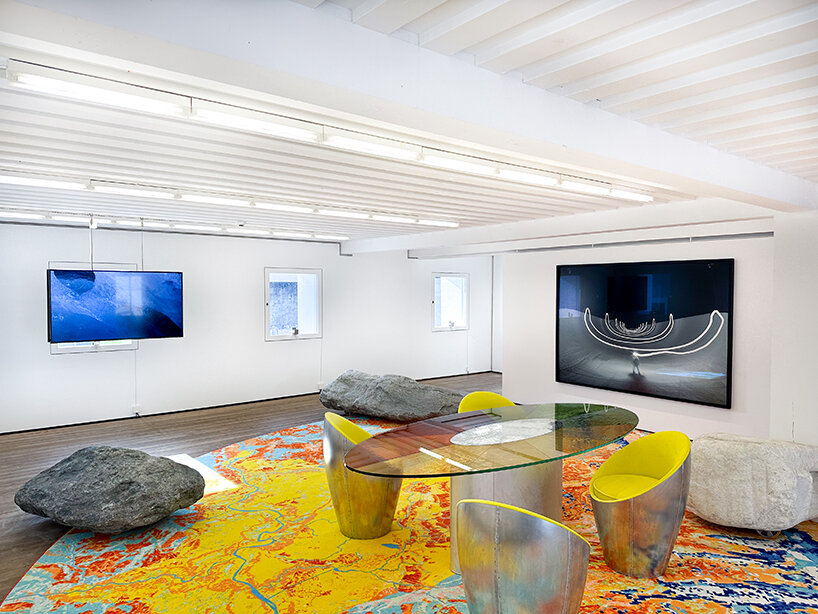
Spatial Solidarities by Studio Other Spaces (SOS)
Studio Other Spaces (SOS), led by artist Olafur Eliasson and architect Sebastian Behmann, unveils their third exhibition, ‘Räumliche Solidaritäten’ (Spatial Solidarities), at Das Gelbe Haus Flims in Switzerland. On view from October 8th, 2023, to October 27th, 2024, the show’s primary objective is to dispel prevalent misconceptions and dichotomies. The exhibition highlights that the mountain and valley, urban and rural, nature and culture are not contradictory or opposing forces but intricately interconnected and mutually reliant, forming the fabric of the region. The exhibition space features vibrant rugs and boulders scattered throughout, along with wooden shelves and wall frames that invite visitors to explore the rich body of work by the SOS team.

installation view of Räumliche Solidaritäten (Spatial Solidarities), at Das Gelbe Haus Flims | image by Gaudenz Danuser
narratives of design & community collaboration at Das Gelbe Haus Flims
The exhibition at Das Gelbe Haus Flims (find more here) adopts a multifaceted narrative approach, presenting a curated collection of projects by Studio Other Spaces (find more here) in conjunction with local initiatives from Flims and the surrounding area. Together, the exhibits delve into inventive solutions for agricultural, social, and infrastructural challenges. The show draws inspiration from the themes that serve as the foundation for Studio Other Spaces’ design and research pursuits, encompassing energy, infrastructure, agriculture, nutrition, and education. The selection of local projects has been guided by co-curators Damian Christinger and Elizabeth McTernan.
This exhibition mirrors the studio’s intertwined interests as both a hub for architecture and art. It shares pioneering design tools, melding traditional craftsmanship with cutting-edge building techniques, promoting sustainable food systems, renewable energy, fostering urban-rural collaboration, valuing local wisdom, emphasizing site-specificity, and embracing a ‘more-than-human’ perspective. Through collaboration with regional partners, SOS strives to develop a meaningful relationship with the environments they typically encounter as ‘outsiders.’ By highlighting the interconnectedness of regional endeavors and weaving a network of connections between projects, SOS stimulates a dynamic exchange with urban centers, research institutions, and independent artisans.

the show seeks to dispel prevalent misconceptions and dichotomies, highlighting that urban and rural are not contradictory but intricately interconnected | image by Studio Other Spaces
Voices of the Landscape: Echoes of Spatial Solidarities
The exhibition further highlights sources of conflict within the region to emphasize that tension is an inherent element in any transformative community process. It also features elements and entities that are not explicitly shaped by human endeavors but play significant roles in the local landscape. Examples include the imposing Zervreila dam wall, which has altered the ecosystems and acoustics of the area beneath it, Icelandic moss and its distinctive role in Rhaeto-Romanic folklore, and the age-old Flims landslide upon which the region’s foundations rest.
‘Spatial Solidarities invites visitors into the spaces of dialogue that are foundational to our work at Studio Other Spaces. The exhibition is not about showing architectural work but about doing it. Das Gelbe Haus reverberates with voices, agencies, collaborations, and experiments from Flims and the surroundings. To access this expansive network, we spent time with the people who live, work, and experiment in the valleys and mountains of the region. The exhibition draws attention to local projects, their interdependences, and their placemaking qualities,’ Sebastian Behmann, co-founder of SOS, explains.
‘If you listen carefully, you will hear places and more-than-human beings talk. The mountain speaks, the river, the valley, the city, the sky, and, here in Flims, even the landslide speaks from 10,000 years ago. All these places and landmarks, which we often take for granted as static, are in constant, if imperceptible, motion. To those who listen, they speak of time and movement, entanglements, and change. Listening is an act of solidarity – with other people, more-than-human beings, objects, and environments. In all their diversity and complexity, these acts of solidarity – these solidarities – form Räumliche Solidaritäten,’ Olafur Eliasson, co-founder of SOS, adds.

‘the exhibition is not about showing architectural work but about doing it,’ shares Sebastian Behmann | image by Gaudenz Danuser

the exhibition interior is adorned with large rugs with vibrant splashes of color | image by Gaudenz Danuser

